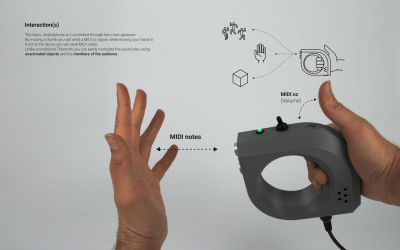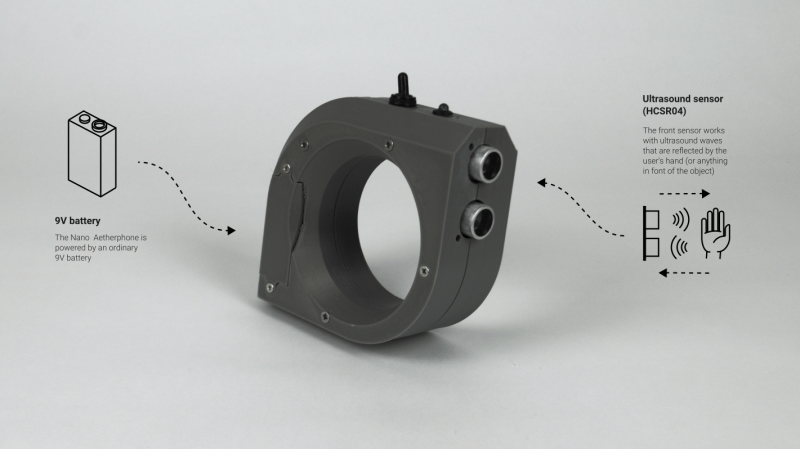MIDI controllers can be simple straightforward keyboards, or wild magical devices that seem to snatch notes from the very aether itself. As you might expect from the name, the Nanoaetherphone II is one of the latter.
 The device is inspired by the Theremin, and was built to celebrate its 100th anniversary. The Nanoaetherphone II is all about using sensors to capture data from wireless hand-wavey interactions, and turn it into MIDI messages. To this end, it has an LDR sensor for detecting light levels, which determines volume levels. This is actuated by the user’s thumb, blocking the sensor or allowing ambient light to reach it. At the front of the handheld unit, there is also an ultrasonic range sensor. Depending on how close the sensor is to the user’s hand or other object determines the exact note sent by the device. As a MIDI controller, it is intended to be hooked up to an external synthesizer to actually generate sound.
The device is inspired by the Theremin, and was built to celebrate its 100th anniversary. The Nanoaetherphone II is all about using sensors to capture data from wireless hand-wavey interactions, and turn it into MIDI messages. To this end, it has an LDR sensor for detecting light levels, which determines volume levels. This is actuated by the user’s thumb, blocking the sensor or allowing ambient light to reach it. At the front of the handheld unit, there is also an ultrasonic range sensor. Depending on how close the sensor is to the user’s hand or other object determines the exact note sent by the device. As a MIDI controller, it is intended to be hooked up to an external synthesizer to actually generate sound.
The overall concept isn’t too complicated, and the design makes it easy to pickup and play. We imagine it could even be foolproofed by programming it only to play notes from a given scale or mode, allowing for easy soloing without too many of those ill-tempered blue notes. Jazz enthusiasts might prefer it to just spit out any and all notes, of course.
We love a good MIDI controller around these parts, and we’ve seen everything from knitted models to those made out of old phones. Video after the break.
















Make it just a centimeter smaller and I could wear it on my /not/ leg.
Oh my…
At first I was “waw!” And then I put the sound on and “Ooo so it doesn’t work”
But .. continuing the development should make the device great !
As a “Jazz Enthusiast” I feel personally attacked. We’re not 12 tone row barbarians.
I have often described jazz as “music for musicians to play for each other. ” It’s overly simplistic, and not really fair, but I feel like it’s not entirely wrong.
As a unmarked neck slide guitarist I feel the blues.
This might do for glitch noise.
This is very similar to a theremin that I made something like 10 years ago. Just like this one, it used an Arduino Nano, and the only real difference is that it didn’t have a MIDI output, but just a square wave that drives a piezo speaker.
It had a touch button made using a pair of GPIOs, and a 1 penny coin as the sensing element stuck to the inside of the enclosure, which would be used to change the operating mode.
It had three modes:
1. Continuous sweep
2. Notes steps defined by frequency
3. Same as 2 but with a higher pitch.
It is probably at the bottom of some drawer, but this new version, makes me want to upgrade it to have a MIDI output instead.
This thing is ridiculous… Are there other undescribed sensors or something? Hardly deserving of the “nano” tag when it’s a giant handle /battery with LDIR.
Hmmmm, not sure but to me, it reminds me of Roland’s D-Beam. What am I missing? There are several very interesting midi controllers out there, especially those that employ MPE. I’d like to see more diverse applications before I can make a qualified judgement.
Interesting but, I for now will stick with my Jamstick Studio midi guitar. Each string on it’s own channel makes for some wild tunes😁
Kinda like an AirHarp… ;-)